How Energy AnalytiX Works

Energy AnalytiX is an analytics data-driven application for Energy Management. It operates by collecting data from various data sources (real time, historical, Web services-based, external, etc.) and then utilizes the collected data in evaluating user-defined energy calculations.
New Energy AnalytiX Installation
The Energy AnalytiX version released with ICONICS' 10.97.xx product release is a new version of the previous releases of Energy AnalytiX (including 10.95.xx), based on a new architecture. For new energy application deployments, the product installation will take care of all the required modules installations along with sample data.
The new Energy AnalytiX is not backwards-compatible nor does an upgrade path currently exists. If the newer version of Energy AnalytiX is installed over an existing installation, the following items should be taken into consideration:
-
The internal product version of the legacy Energy AnalytiX is different than the one included with the new Energy AnalytiX.
-
The old Energy AnalytiX version modules will not be included in the new product release nor will they be updated to accommodate different functionality,
-
Energy Charts will be replaced by an energy dashboard based on KPIWorX-BI and TrendWorX64 Viewer.
-
Energy reporting will be replaced by direct Hyper Historian data access since, with the new product version, all energy data are stored in Hyper Historian.
-
All CLR database stored procedures for accessing legacy energy data will no longer be supported.
-
The table naming convention for the old and new versions are also different.
-
The old product version database object definition use the EA_ prefix.
-
The new product version database object definitions use the EaASC_ prefix.
-
Upon installation of the new product version, the database tables of the older product will not be deleted and they will be left intact.
-
After installation of the new product, no Energy Asset extensions will be visible and any energy-related settings with respect to the old product version will be lost.
To enable using the new Energy AnalytiX product version, the user must perform the following steps:
-
Upon installation of the newer product version, the user will need to upgrade any existing databases by using the Configure Applications Settings tool.
-
Ideally, after this step, it is advised for the user to create a backup of the existing AssetWorX configuration database.
-
Next, the end user will need to use the Configure Database tool in Workbench to Install Assets AnalytiX, Hyper Historian (if not already installed), Triggers (if not already installed) and the NEW Energy AnalytiX to an updated AssetWorX database.
-
Finally, the user should inspect the Configure Application Settings tool to make sure that the Energy AnalytiX is included and enabled.
Once all of the above steps are completed, the user should be able to add new Energy AnalytiX extensions to existing assets in the AssetWorX tree.
Energy AnalytiX Modules
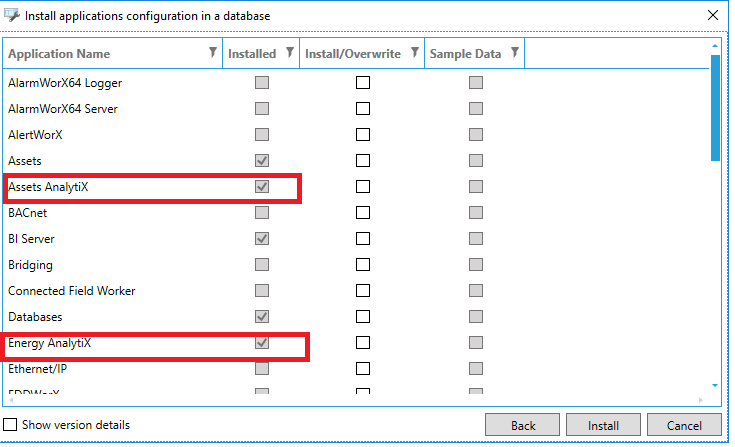
NOTE: For the new Energy AnalytiX to function properly, the following configurations and applications need to reside within the same configuration database:
-
Assets
-
Asset AnalytiX
-
Hyper Historian
-
Energy AnalytiX
-
Triggers, AnalytiX-BI
Energy AnalytiX integrates a number of ICONICS key technologies in order to provide an energy management solution.
-
Asset AnalytiX
-
Hyper Historian
-
AnalytiX-BI
-
KPIWorX-BI
Energy AnalytiX is deployed using the AssetWorX infrastructure along with Asset AnalytiX support for mapping equipment properties to Hyper Historian tags and calculations. As such, an end user can add energy functionality to any asset using the Energy AnalytiX extension in the Workbench.
High Level Architecture of Energy AnalytiX
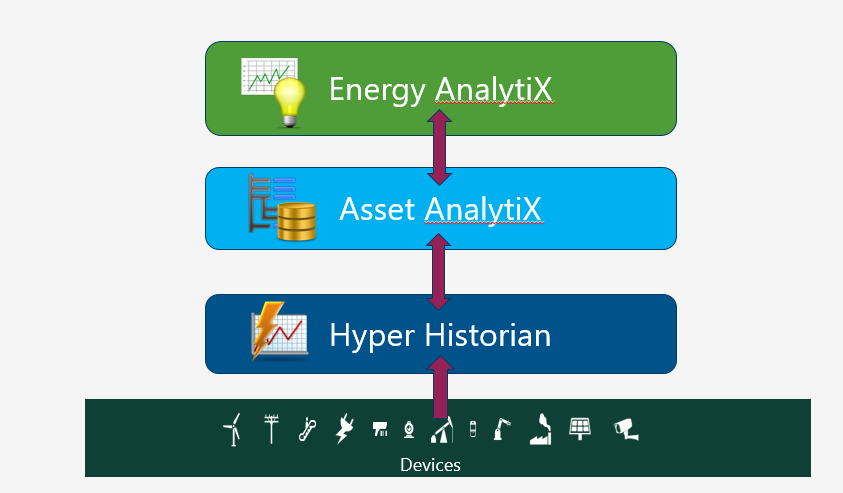
The overall energy application functionality is based on the following steps
-
Define energy management (extension) on assets.
-
Expose energy data as AssetWorX/Hyper Historian data sources.
-
Transparently propagate data collections and calculations to Hyper Historian by using Asset AnalytiX as a platform.
-
Implement core Energy Analysis calculations as a function library.
-
Make all data available through AssetWorX or Hyper Historian data access interface.
When the user installs Energy AnalytiX, a new energy related function library is added to Hyper Historian, which implements the logic for processing energy-related calculations inside Hyper Historian.
NOTE: For Energy AnalytiX to properly collect and display data, the following services must be running:
-
AssetWorX Point Manager
-
Provides data access for energy data.
-
Hyper Historian Logger Service
-
Central data collection and data calculations repository.
-
Provides data access to energy data.
-
Energy AnalytiX Service
-
Backgound tasks service for energy data.
-
Supports meter data spikes repairs.
-
Support Energy Star data extracts.
-
AnalytiX-BI Point Manager
-
Hosts energy analysis data model for the energy dashboard.
-
Triggers Service
-
Schedules periodic tasks.
Energy Related Function Library in Hyper Historian
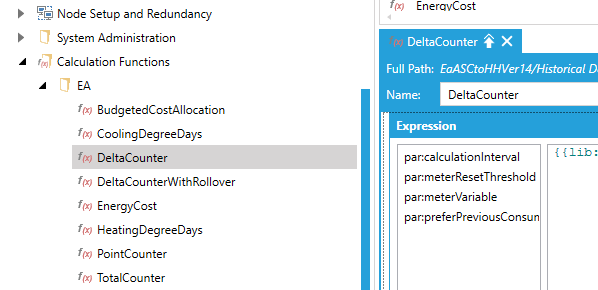
In addition, a number of pre-configured Hyper Historian calculation triggers are created to process the various energy calculations based on the AssetWorX tree level and related processing time and phases
Energy AnalytiX Related Calculation Triggers in Hyper Historian
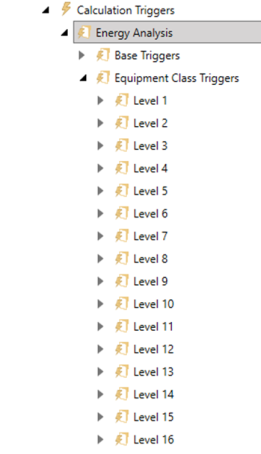
Important Note: The pre-created triggers to process energy calculations can accommodate up to 16 levels deep of asset hierarchy.
NOTE: All entities created by Energy AnalytiX installation, such as energy function library folders, calculation triggers, AnalytiX-BI energy-related data model,and Periodic Triggers under Actions should NOT be deleted or renamed by the end user. Otherwise, the Energy AnalytiX product functionality may be compromised.
The overall process to add an Energy AnalytiX extension to an asset is a three-step approach.
-
User configures an Energy Asset in Workbench Desktop.
-
The Energy AnalytiX provider will ….
-
Set related variables and calculations as AssetWorX equipment properties mapped to Hyper Historian.
-
Add additional Hyper Historian performance calculations as needed.
-
The end user can access all energy data using the AssetWorX point manager or the Hyper Historian point manager in all ICONICS client applications.
Energy Asset with Energy Variables and Calculations Exposed as AssetWorX Equipment Properties mapped to Hyper Historian Tags and Calculations
Energy AnalytiX-based Equipment Properties
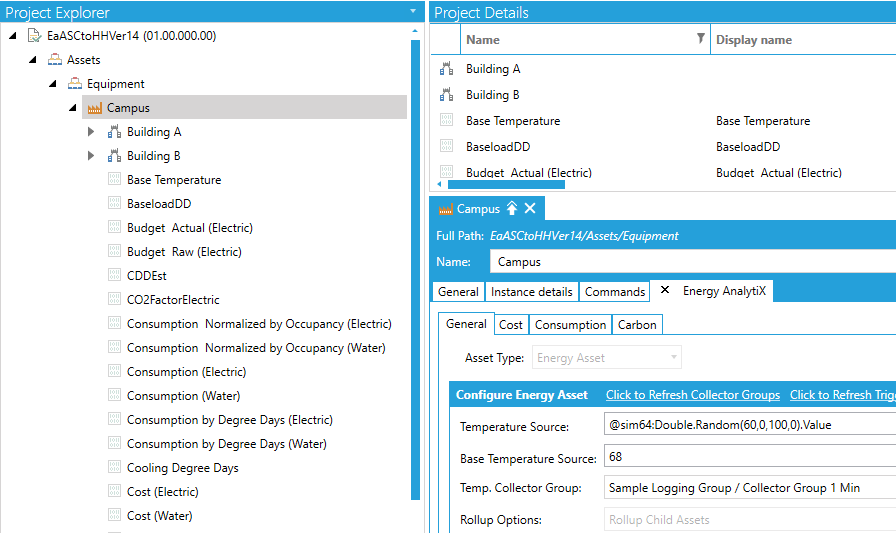
We have also modified the properties of the energy related calculated equipment properties to reference the historical point name to which the calculated property is mapped to and set the real time tag to dynamic tag.
_507x351.png)
In this way it can be directly referenced by graphics clients as a real-time asset equipment property.
Then, the end user can browse for all energy-related data using the standard ICONICS data browser.
Energy Data Exposed through Hyper Historian in Data Browser
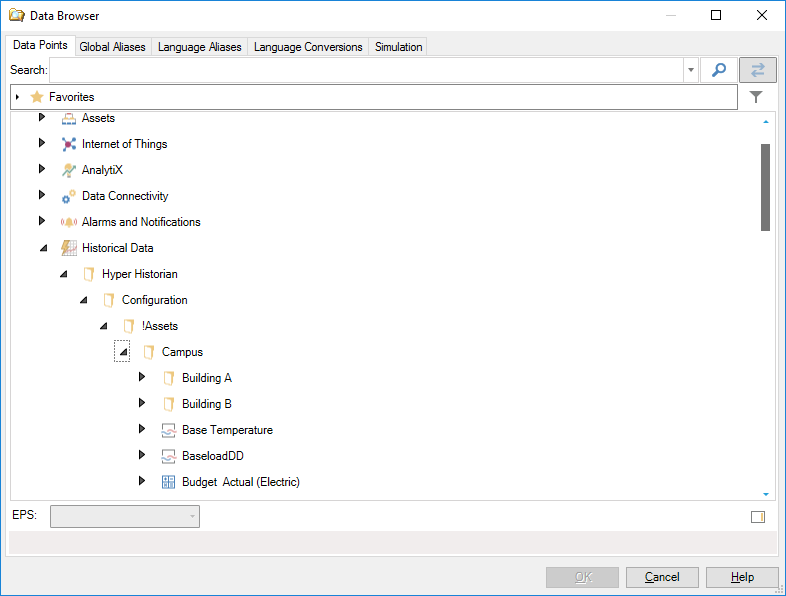
Energy AnalytiX at a Glance

Energy AnalytiX classifies the collected data by functionality, including:
-
Meter Data
-
Weather Data
-
Cost Data
-
Energy Variables (such as occupancy)
-
Energy Calculations
Internally, it creates interval-based data both for meter summaries as well as energy calculations for key periods. such as:
-
Base Summary Interval (e.g., every 15, 20, or 30 minutes, etc.)
as well as optional time interval energy calculations for
-
Hourly Summary Interval (e.g. every hour)
-
Daily Summary Interval (e.g. every day)
-
Monthly Summary Interval (e.g. every month)
-
Yearly Summary Interval (e.g. every year)
The above interval defines the output resolution of energy calculations such as consumption, cost or carbon.
In addition, Energy AnalytiX utilizes energy variables to produce rich energy-related analytical data, which can be easily displayed in built-in charts and reports as well as third-party analytical tools such as Power BI.
In order to facilitate advanced analytical capabilities, Energy AnalytiX utilizes several key concepts at the provider configuration level.
Expanded Energy AnalytiX Provider in the Project Explorer in the Workbench
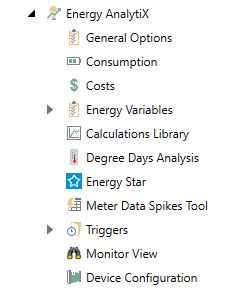
These key concepts provide rich analytics results and allow Energy AnalytiX to support advanced data insights and reports. The following are key concepts within Energy AnalytiX.
Asset Tree
The AssetWorX Asset tree is utilized to add Energy AnalytiX extensions to user-configured assets. Using the Asset tree, Energy AnalytiX supports three types of Energy related assets:
-
Regular Energy Asset - Such as Building, Room, Manufacturing Cell, etc.
-
Energy Meter - Such as Electric, Water, Gas, etc. Meters
Example of Assets in the AssetWorX Provider in the Project Explorer in the Workbench
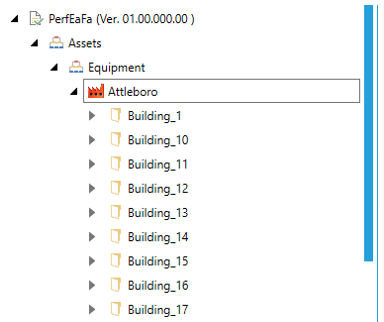
Meter Types
Meter types are utilized to provide/analyze energy data from energy sources such as electric, water, and gas. They are quite flexible and can even be used for non-energy source related counts such as production counts, plug load association, etc. Meter types can also be used to support energy source segmentation, by defining appropriate meter types such as those in the image below.
Meter Type Examples (Under the Consumption Node in the Energy AnalytiX Provider)
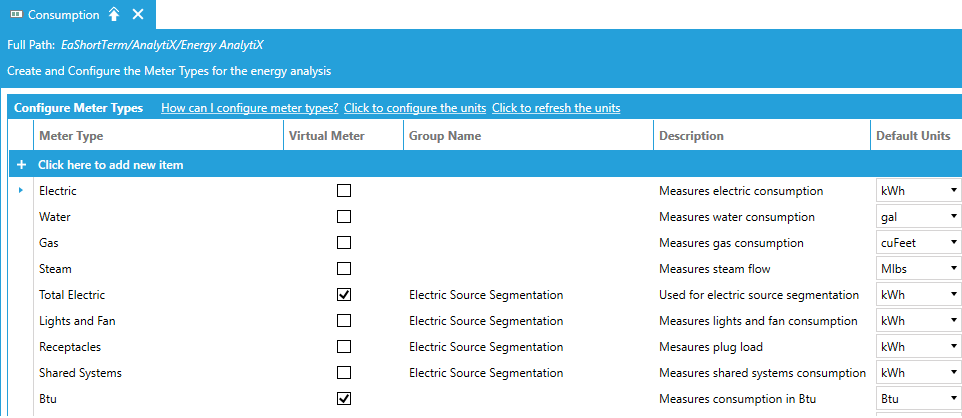
Runtime charts and reports use meter types to drill down to specific energy-related data.
Cost Centers
Cost Centers are used for cost allocation, such as organizational areas or tenants, and for estimating energy cost. They can also be used to logically filter areas of energy reporting and to quickly identify possibilities for further improvements.
Costs Node in Energy AnalytiX Provider in the Workbench

Energy Variables
Energy variables are used as calculation variables in defining energy calculations, such as energy consumption normalized by square footage. They can be static or time varying.
Energy Variables Node (and Subnodes) in Energy AnalytiX Provider in the Workbench
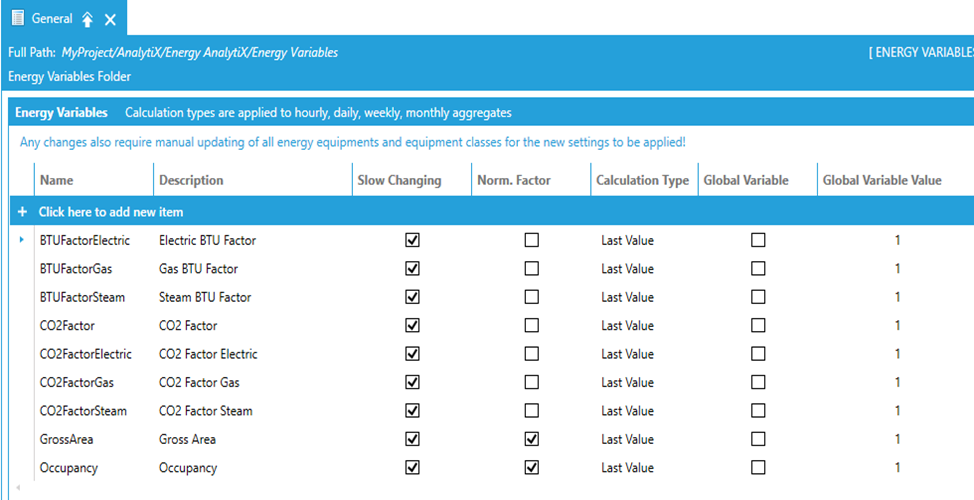
There is also a special category of “internal” energy variables, which cannot be edited by end users. The “internal” energy variables are handled transparently by the Energy AnalytiX runtime to provide support for certain energy calculations.
Internal Energy Variables in Energy AnalytiX Provider in the Workbench`

Calculations Categories and Calculations Library
Energy AnalytiX supports multiple types of energy calculations: standard, derived, carbon and cost.
-
Standard consumption calculations are based on meter data variables.
-
Derived calculations are based on standard calculation data variables and energys variable values. They are used for normalized consumption values, defining custom cost calculations or in any custom calculation that an end user would like to define.
-
Carbon calculations are a special category of derived calculations targeting carbon emissions.
-
Cost calculations require no configuration and are built into Energy AnalytiX runtime. The user only needs to enable them.
Calculations Configuration in Energy AnalytiX (Consumption Tab Shown)
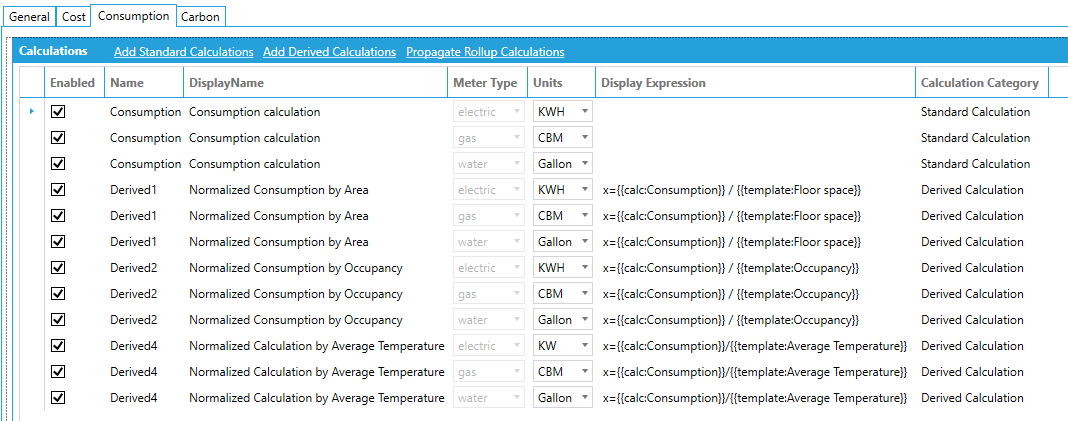
Calculation Categories are used to categorize energy calculations data in groups, so that the runtime charts and reports can produce meaningful visualization and reporting results. They are also used in runtime filtering operations.
Calculation Categories Tab in Calculations Library Configuration in Energy AnalytiX
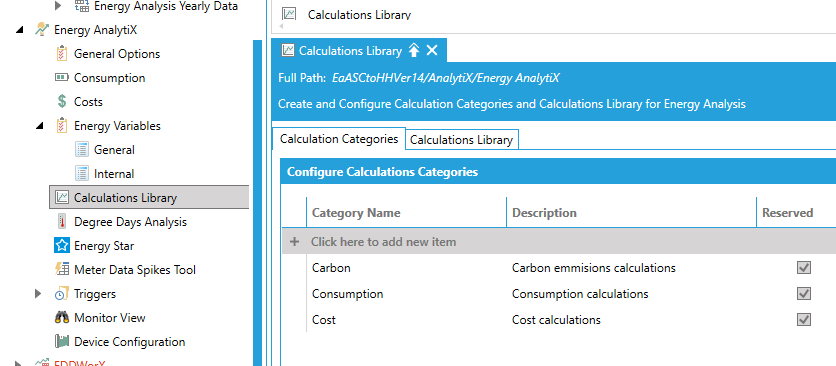
The Calculations Library is a set of predefined derived energy calculations that are installed with Energy AnalytiX. End users can define more and the Calculation Library enables the definition of the required energy calculations in a template manner in order to accelerate associating the calculations to actual energy assets.
Calculations Library Tab
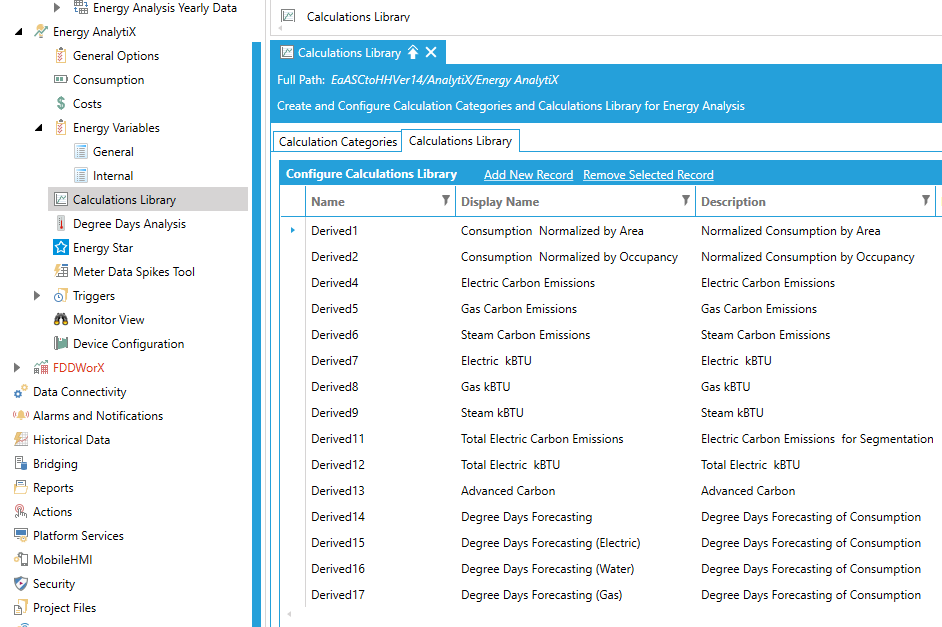
Energy Star
Energy AnalytiX allows the end user to associate energy meters with Energy Star reporting. The end goal is to fill in an approved Energy Start reporting template for manual submission to the Energy Star Portfolio Manager.
In addition, the user will have options to periodically extract formatted data for energy meters to the AssetWorx MS SQL server configuration database for manual reporting to Energy Star.
Energy Star Configuration in Energy AnalytiX
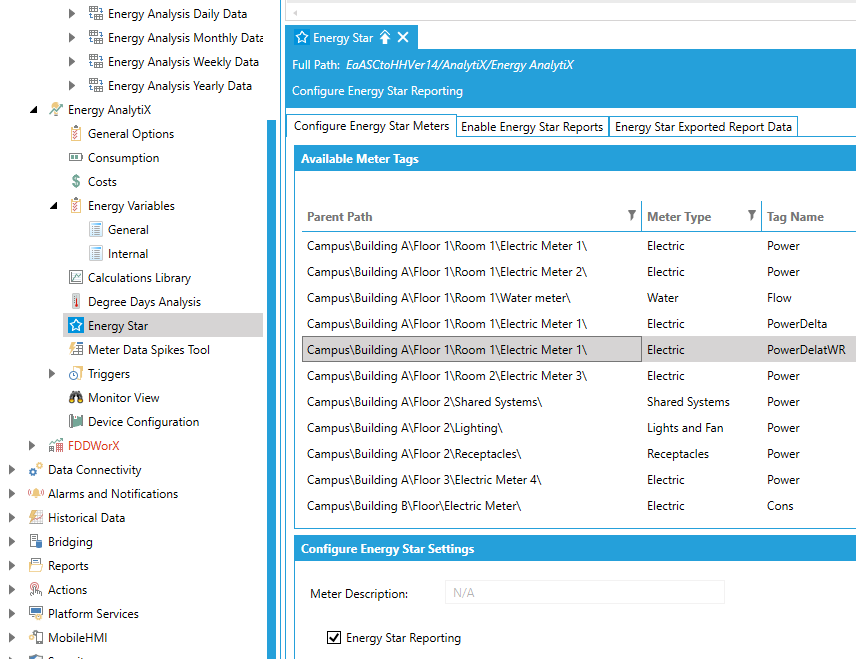
Energy Star Data Extracts in Energy AnalytiX
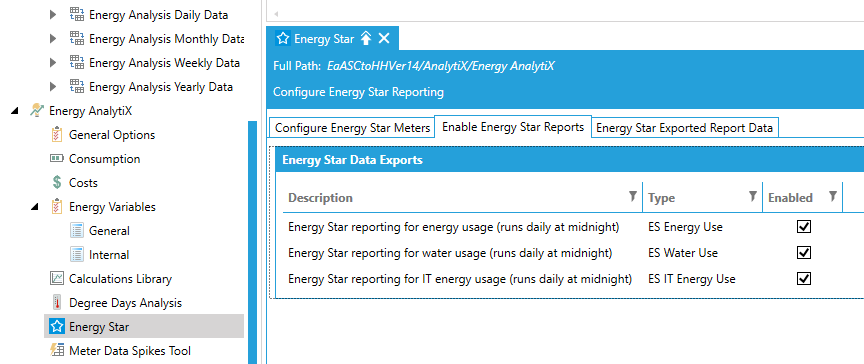
Energy AnalytiX also installs a number of approved Energy Star templates under:
C:\Program Files\ICONICS\GENESIS64\Components\Templates\Energy Star\Report Templates
Energy Star Report Templates
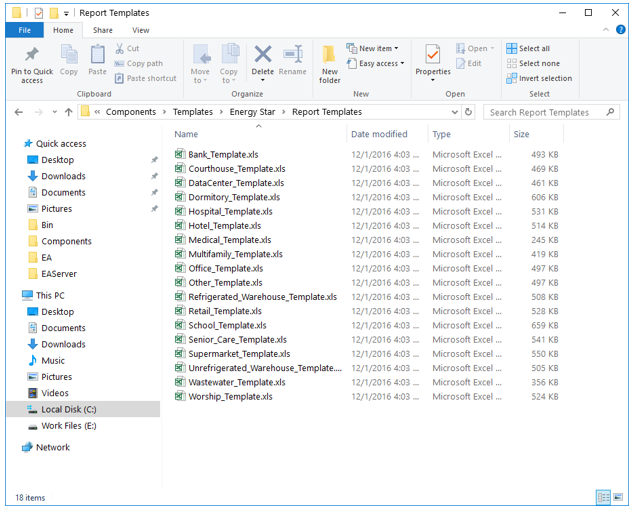
Periodic Triggers
Periodic Triggers are utilized to trigger data retrieval for Energy Star-configured energy meters from Hyper Historian.
Periodic Triggers in Energy AnalytiX
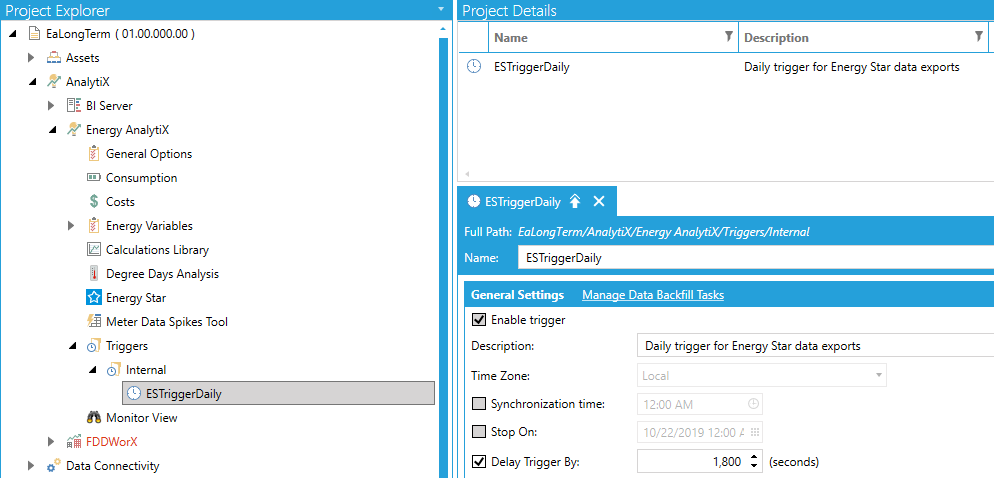
A pre-defined trigger, ESTriggerDaily, which can only be partially edited by the end user, is created to facilitate scheduling, on a daily basis. the extraction of Energy Star-formatted data from Hyper Historian to an AssetWorX Microsoft SQL database.
Equipment Classes
Equipment Classes are a special kind of asset (equipment), which have parameterized configuration properties. They can be used to rapidly configure an Energy AnalytiX application. When a user creates an AssetWorX database in the Workbench that includes an Energy AnalytiX extension, several pre-built equipment classes are added to facilitate common energy analysis scenarios.
Equipment Classes Example
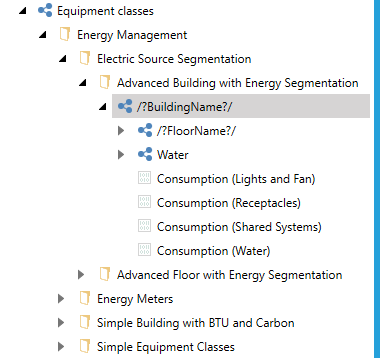
See Also: